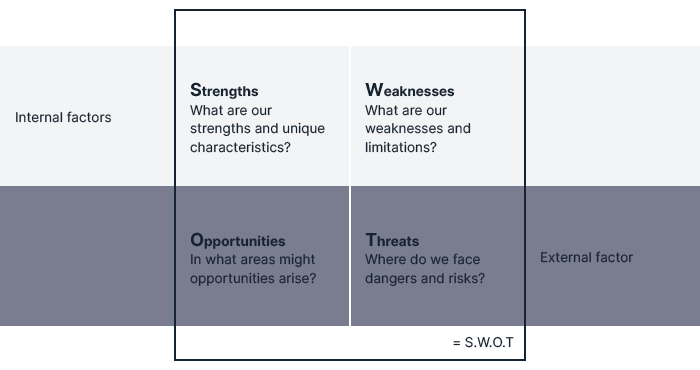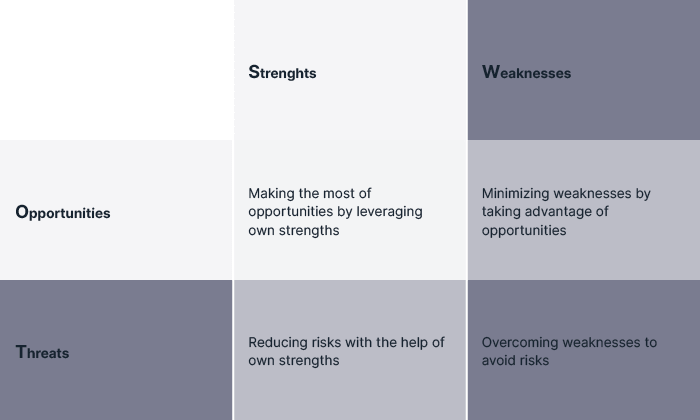If you have ever worked in the business or entrepreneurial field, you have surely come across the term SWOT analysis. The method is extremely effective when it comes to evaluating a company, because it is a strategic planning tool designed to help obtain a clear overview of the status quo and uncover the need for strategic action.
With this purpose, however, SWOT analysis not only serves the entrepreneurial spirit very well. It is also an excellent tool for project evaluation and thus may very well be considered as a basis for the start of any project. Properly implemented, the analysis will highlight where the project stands in terms of its market positioning, its competition as well as its competitive advantages.
In this article, you will learn what a SWOT analysis is and how you can apply it to your project. Let's dive deeper!
What is a SWOT analysis?
Every company has its strengths and weaknesses and it is absolutely necessary to know them. However, how these strengths and weaknesses come to light is determined by the market, from which a number of opportunities and threats arise. Those who know their strengths know how to take advantage of opportunities as they arise. Those who know their weaknesses are able to deal with risks more effectively. The success of a company is therefore largely determined by the interaction of internal and external factors... and the same applies to a planned project.
In the course of a SWOT analysis, one is centrally concerned with revealing these internal and external influencing factors - the strengths, weaknesses, opportunities and threats - of a company or project. In this way, the analysis makes it possible to critically examine the circumstances to find out which obstacles you need to overcome or minimize, and which steps you need to take for short- or long-term success. In connection with the insights gained, it is therefore also possible to define a suitable strategy in project management that can be used to achieve the internal goals.
Setup of the SWOT matrix: Know the influencing factors
The SWOT analysis is visually supported by means of a 4-field matrix, representing the interplay of the influencing factors.

Internal factors: strengths and weaknesses
Strengths and weaknesses are influenced by internal factors, i. e., the resources and expertise available to the project. These may include:
- financial resources
- physical/operational resources
- access to natural resources, trademarks, patents and copyrights
- human resources (HR)
- existing internal processes
Strengths
Positive influencing factors that arise internally, i.e., directly from the project or the company, fall under the heading of strengths. While elaborating on these points, it may be helpful to ask yourself the following questions: What are we good at or even unbeatable at? What makes us stand out from the competition? What are we particularly proud of? Maybe it's contacts with important decision-makers or media houses, a particularly good image or access to specialist knowledge.
Weaknesses
On the other hand, all negative internal influencing factors can be found in the area of weaknesses. What are we terrible at, or simply worse than others? In which areas do we often struggle? Perhaps we lack experience in certain areas, functioning processes, financial reserves or relevant contacts.
External factors: opportunities and threats
External factors that have an impact on a project or on a company are associated with opportunities and threats. They generally refer to situations that are beyond your control, such as:
- market developments or trends
- economic and political developments
- demographic shifts
- relationships with suppliers or partners
- political, environmental or economical regulations
Opportunities
Opportunities are usually strictly external factors that you cannot influence yourself - for example, social aspects that create the potential to support your project or attract public attention.
Example?
- public debates, triggered by a specific event, that attracts media attention
- Political decisions and legislative enactments that support your own goals
- Planned national or international projects that you can build on or benefit from
Risks/threats
On the other hand, external factors can of course also pose risks to your project. While political decisions and public debates can support your goals, they can also hinder them. Even the Corona crisis resulted - in purely economic terms - in both "losers" (the restaurant industry) and "winners" (software developers of home office or entertainment services).
Drawing measures: Know the interplay
When you perform a SWOT analysis, you should not merely list the individual influencing factors, but also consider them as an overall picture. Hence, you should also take into account the interdependency of individual points.
- What strengths can I use to take advantage of my opportunities as well?
- What strengths will help to minimize risks?
- What opportunities can I use to minimize my weaknesses?
- What weaknesses do I need to minimize to avoid risks?

What should I pay attention to during the SWOT analysis?
The SWOT matrix seems very simple at first glance, but filling it out is usually not as easy as it seems. Here's how to get the most out of the analysis:
- Be realistic about the current state of the project or organization. If in doubt, it's a good idea to briefly consult with the team and work together to determine what aspects should and should not be assigned to a field.
- Focus on the here and now, because the matrix should only describe the current state. Everything about the past and future must be left out. Especially when filling in the opportunity quadrant, you can easily go astray.
- Don't get too specific. A SWOT matrix should be straightforward, so that the core message of each point within the quadrants remains obvious.
Doing a SWOT analysis in 5 steps
Step 1: Set clear goals
As in so many cases, setting specific goals is also at the top of the list when doing a SWOT analysis. So the first question you ask yourself is this, "Where do we want to go?" During the analysis, you will then determine where the project is right now and how you can actually move toward your goal.
Step 2: Assemble a team
The best way to do a SWOT analysis is not to do it alone, as your colleagues can absolutely help you work out the influencing factors as comprehensively as possible and from different perspectives of different departments. Explain exactly how the analysis works and how you will go about it.
Step 3: Explore the internal factors
To optimally cover the internal factors, it is best to create a criteria catalog that covers all important areas and serves as a basis for a final target/actual comparison. Further break down these areas, which will make them easier to evaluate later. Here are some examples:
- Product: unique selling points, potential for improvement, etc.
- Human resources: know-how, staff turnover, workload, etc.
- Finance: Liquidity ratio, equity and debt ratio, etc.
Step 4: Examine the external factors using PESTLE and Porter
To analyze the project in terms of its external influencing factors, you need to examine two important areas: the macro-environment and the micro-environment.
Use the PESTLE analysis to examine the macroenvironment.
The PESTLE analysis is specifically designed to examine the extent to which various macro-environmental factors can affect a company and its competitiveness. Consideration is given to political, economic, socio-cultural, technological, legal and ecological factors.
Use Porter's Five Forces to examine the microenvironment.
In contrast, industry structure analysis aka Porter's Five Forces can be used to determine the balance of power in an industry in terms of competition, customers, suppliers, substitution threats, and the potential of new entrants into the industry.
Step 5: Derive measures and strategies
The last step is also the most important. At this point, concrete strategies that can actually be used to improve the current state come into being. As mentioned above, study the interrelationships between the influencing factors and derive strategic measures from them.
The SWOT analysis is so popular because it has a low complexity and a high flexibility regarding its field of application. It is just as popular in marketing and project management as it is in strategic management and business formation. Properly conducted, it provides you with an insightful snapshot of your project, including all factors that can determine its success or failure.